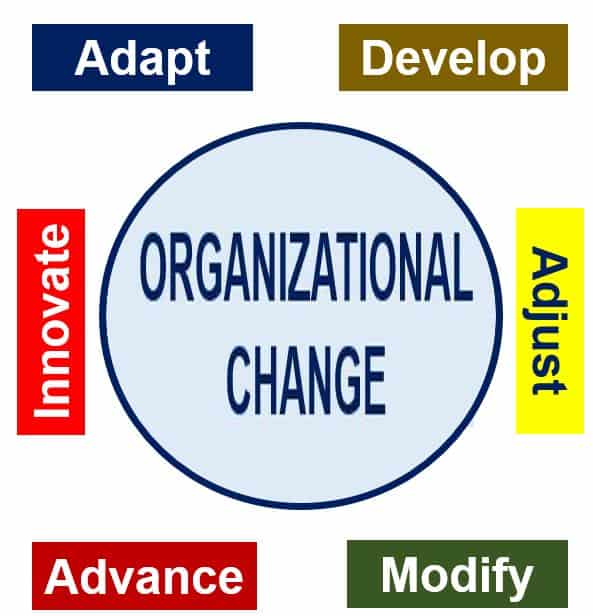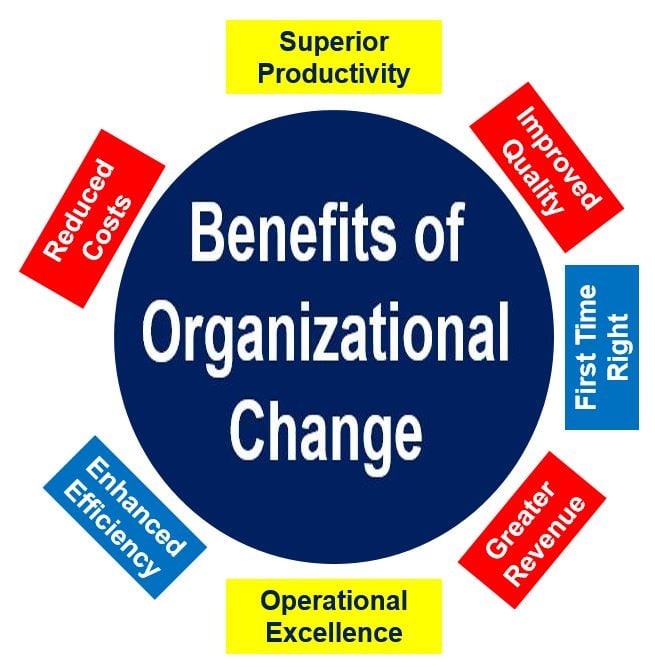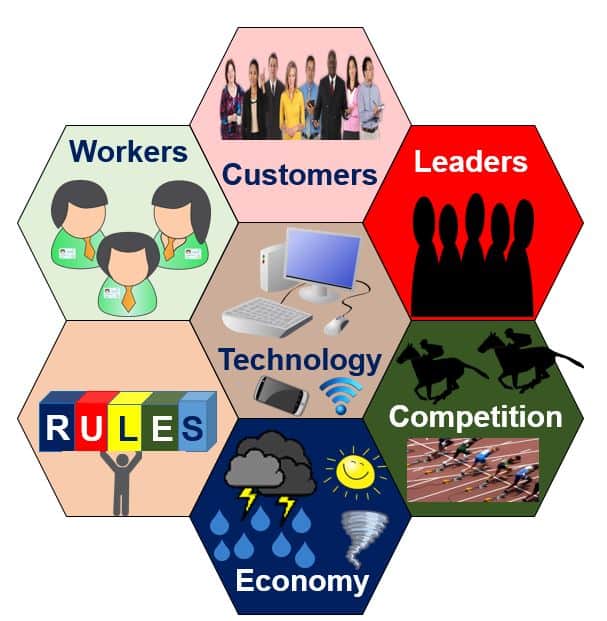Which Of The Following Is An Example Of A Structural Organizational Change?
Organizational Alter looks both at the procedure in which a visitor or any organization changes its operational methods, technologies, organizational structure, whole structure, or strategies, as well as what effects these changes have on it. Organizational change usually happens in response to – or as a result of – external or internal pressures.
It is all about reviewing and modifying structures – specifically management structures – and business processes.
Small commercial enterprises need to adapt to survive against larger competitors. They also need to acquire to thrive in that environment. Large rivals need to adapt chop-chop when a smaller, innovative competitor comes onto the scene.
To avoid falling behind, or to remain a step ahead of its rivals, a business must seek out ways to operate more than efficiently. It must also strive to operate more cost finer.

Ever since the advent of the Internet, the business environment today has been changing at a considerably faster pace compared to forty years agone. Organizational modify is a requirement for whatsoever business that wants to survive and thrive.
Organizational alter – comprehend it!
Change is something that should be embraced rather than feared. Only with modify volition businesses exist able to lay the foundations for long-term success.
According to Cambridge Lexicon, organizational change is:
"A procedure in which a large visitor or organization changes its working methods or aims, for example in society to develop and deal with new situations or markets."
Many people would disagree with Cambridge Dictionary's clarification. They say the definition should not limit organizational change just to something that happens in large companies.
Organizational change drivers
An system'due south change drivers include:
The economical climate
The term 'economic climate' ways the state of the overall economy, i.e., economic conditions.
If at that place is a recession, a company may have to lay off workers; this requires restructuring.
A merger or takeover also means total reorganization and changes in corporate culture.
Corporate civilization or organizational culture is a group of internal values and behaviors inside an organization.
Consumer need & beliefs
People's lifestyles and how they shop, work, and spend their leisure times are forever changing. Since the advent of the Internet, these changes take been occurring at significantly faster rates.

If you run a business today and hope that the pace of change will slow down, you will be in for a huge disappointment. Without change, your company volition lose its competitive edge. Information technology will too fail to run across the requirements of what most of united states of america hope will exist a growing base of loyal customers.
New technologies
New hi-tech systems and devices have completely changed how commercial enterprises exercise business and interact with other entities in the marketplace.
Business concern models such as virtual collaboration and outsourcing are only possible today cheers to the Internet and ultra-high-speed communications.
Without technological change, our business leaders would still be dictating correspondence to human being beings, who would and so blazon them out and adjust for them to be distributed to the relevant people – wasting an incredible amount of time and resource.
The competitive market
If a new rival comes onto the scene with completely different commercial behaviors, the other players may have to adapt, especially if that competitor is successful in gaining market share.
Rules and regulations (government policy)
When companies are faced with new legislation or rules imposed past the relevant regulatory authorities, they need to practice two things: i. Comply with them. 2. Adapt and then that they may keep to thrive.
Types of organizational modify
What type of organizational change a company requires or is going through varies, depending on the person's point of view.
A manager in applied science may come across it in terms of systems, tools, software, hardware, etc. The CEO will invariably perceive change in terms of structure and strategy.
The operations manager, on the other manus, will mainly come across information technology in terms of processes, etc.
In the majority of cases, the change is and then complex and intricate that nobody tin define information technology fully from a specific standpoint.
Below are some of the common types of organizational change. Conduct in listen that there is some or pregnant overlap between them:
Mission and Strategy
This is all about the company's aims and goals and how information technology plans to achieve them. Hardly whatsoever change in an organization is not related to its mission and strategy.
Mission and strategy touch on every part of a business. Therefore, whatever change in this area has a company-wide impact.
Policies and Legal Agreements
Changing policies and legal agreements may exist highly unpopular with customers and the workforce.
Whatever change in this expanse, fifty-fifty a minor one, may have a significant bear on on a visitor.
Organizational Structure
The term refers to the hierarchy within an organization, which defines each task and department, their office, and where they study to.
When ii commercial enterprises merge, or i takes over another, there are major structural changes. Sometimes the change may be pocket-sized, such as when a new team is established.
Processes
This term refers to a collection of linked tasks which discover their stop in the commitment of a production or service to a consumer.
Processes and tasks are normally contradistinct during organizational change. In some organizations, changing or upgrading processes is ongoing or occurs on a regular basis.
Personnel
Personnel means staff or human resources, i.eastward., the employees. It includes hiring, firing, training, roles, responsibilities, and other changes related to the workforce.
Culture
Culture refers to the pervasive beliefs, values, and attitudes that characterize a house and guide its practices.
Whatsoever modify in these areas tin have a profound impact on every attribute of the organisation.
It can have an impact on, for case, productivity, compliance, and innovation.
Products
This is all virtually changes to products, and everything related to encouraging consumers to buy them. Marketing and sales are an essential focus for almost organizations.
Knowledge
Noesis supports every product, process, initiative, projection, and plan. Modify here refers to the cognition assets of the company.
Knowledge avails are the information or skills within an system that make information technology more competitive or valuable.
Engineering
Today, virtually every commercial enterprise is a kind of tech company.
Sometimes, a company makes changes to its technology infrastructure, automation, systems, hardware, software, etc.
Integration
Integration includes synchronizing Information technology (information technology) and business cultures and objectives, aligning technology with company strategy and goals.
In a company, integration is a reflection of how people are absorbing Information technology equally a function of the organization.
Most every change requires integration. We must marshal everything in a visitor so that they support, compliment, and add value to each other.
Integration is normally the almost complex type of change. When carried out successfully, the whole company is clearly much more than valuable than the sum of its parts.

Experts say that a fundamental aspect of introducing planned changes into any environment is to gain insights into how well they will exist received by employees and customers and implemented past the direction, and how accurately the economical climate today and tomorrow is perceived and forecast. Integrating technology across every component of the company and responding adequately to any new rules and regulations are crucial.
The study of organizational change
The written report of organizational change, considering of its very nature, covers some unlike disciplines, including psychology, management, economic science, political science, and folklore.
There is no extensive theory of organizational modify that all experts refer or attach to. Rather, information technology consists of several distinct theories that nobody so far has integrated.
Shawn Grimsley writes in report.com.
"The report of organizational alter is interdisciplinary in nature and draws from the fields of psychology, folklore, political science, economics, and management."
"Yous will not discover a m, unified theory of organizational alter. Instead, you will find distinct theories that have not really been integrated to date."
Organizational modify – failure
Perhaps this is why, in well-nigh cases, when people implement organizational change, it usually fails.
The key decision of a study – 'Where Change Management Fails' – by Robert Half Management Resources, which included 300 senior managers at US companies with at least xx workers, was that organizational change commonly fails.
The report establish that in the majority of cases, the failure occurs in the executional phase. This is due mainly to cleaved or inadequate advice.
Forty-six per centum of respondents said that about alter-management efforts unremarkably failed at execution. However, only 10% claimed information technology occurred during the strategy development phase.
When asked what was well-nigh important when leading their visitor through a major organizational alter, the respondents said:
- Communicating conspicuously and oftentimes: 65%
- Clearly outlining the goals: 16%
- Delegating effectively: 9%
Executive Managing director of Robert Half Management Resources, Tim Hird, explained:
"Whether major or incremental, many companies are initiating changes, from transforming their business models to updating business systems and looking for ways to enhance productivity. While change is never easy for a company, it'southward even harder for employees."
An organization is whatever group of organized people who work together and have a mutual goal.
Video – What is organizational modify?
This video explains what organizational change is and why information technology is important in today'due south marketplace:
Source: https://marketbusinessnews.com/financial-glossary/organizational-change-definition-meaning/
Posted by: jimenezressigirly1956.blogspot.com


0 Response to "Which Of The Following Is An Example Of A Structural Organizational Change?"
Post a Comment